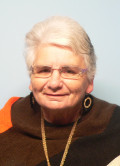
Bethwyn
Bethwyn owes her life to the skills of her Neurosurgeons and her faith. Incredibly, she has survived six aneurysms between 1967 - 2019.
In 1967 it was discovered that Bethwyn had an aneurysm on her the left Carotid Artery. Her neurosurgeon was Dr Trevor Dinning, original co-founder of the NRF. He treated her by tying off the artery at a point halfway up her neck. A full recovery followed, and she went on to marry and in due course have two children.
Then, her first child, a daughter, at 6 weeks of age was diagnosed as having a cyst on the brain. As a measure of her confidence in her own neurosurgeon who had saved her life two years earlier, that same doctor operated successfully on her daughter.
If this was not enough for one person and one family to survive, Bethwyn again proved how lucky she was when she subsequently survived a double aneurysm a day before Christmas 1994. This time things became very serious and complicated. Her previous neurosurgeon had retired, and the newly selected neurosurgeon, Dr Cindy Molloy, performed open craniotomy and successfully corrected one aneurysm by clipping it, only to be immediately confronted by another unexpected nearby rupture of the same artery, also requiring clipping. The resulting loss of blood into the skull was potentially disastrous.
About seven weeks after first admission, Bethwyn went home. The recovery process had been touch and go for a while, but thanks to the skill of her neurosurgeon, the dedicated care of her hospital staff and not least of all her faith in God, she overcame all difficulties.
After this she resumed her normal life, doing the things she loved best, such as knitting, playing the piano, singing in her church choir and enjoying her grandchildren. She was able to do everything she did prior to this latest event, with no loss of function or skill.
Unfortunately, that was not the end of Bethwyn’s experience with aneurysms. Incredibly, 25 years later she cheated death again.
For some months before Christmas 2018 she had severe pain with her right upper arm and very limited mobility. She returned to see her neurosurgeon Dr Molloy, who she had not seen since 1994. Without benefit of any scans, she was diagnosed with fused vertebrae 5 and 6 which a subsequent CT scan confirmed.
Dr Molloy operated in January 2019 – the result seemed positive. Bethwyn was happy and her mobility had returned. Dr Molloy however noticed something odd and found a black spot on the brain. Having indicated that she did not “clip” aneurysms now, she referred Bethwyn to Dr. Steve Chrysiddis, a radiologist / neurologist for an angiogram.
His investigation revealed three aneurysms, two of which required treatment. These were in near proximity to the two that had been clipped in 1994. In August 2019 he successfully treated two of the aneurysms by inserting a stent into the artery and placing it at their exact location, thereby effectively sealing them off and preventing their rupture. The third, as he described was, “left sleeping with a smile on its face, surrounded by tissue and safe and sound.”
Bethwyn is a walking and talking history of neurosurgery. She has survived six aneurysms and has undergone a range of different surgeries which have evolved since 1967 until 2019. This includes tying off an artery, clipping during an open craniotomy, and endovascular repair surgery using stenting (mesh tubes). This latter procedure involved accessing through the groin into an artery and then to the blood vessel in the brain where the aneurysm is located. In her case, insertion of coils into the aneurysm was not considered due to the very fine weave of the stent.
Bethwyn is grateful for her full life which she says is thanks to her neurosurgeons, endovascular surgeons, medical development and faith in God.
Bill, her husband of 52 years jokingly says "next time I get married, I will ignore the good looks and lovely legs and check out the teeth and aneurysms – they are the bits that cost me sleep and money."
Aneurysms can strike anyone at any time and in fact occur spontaneously at a rate of about 1 in 10,000 people. They are more common in adults and most brain aneurysms have no symptoms. If rupture occurs it causes bleeding into the brain, known as a haemorrhagic stroke. Only approximately 50% of patients survive a burst aneurysm, and only a third will recover without any disabilities. The most common symptom of a ruptured aneurysm is a very severe sudden onset headache. Fast accurate diagnosis and successful early neurosurgery within the first 72 hours produces the best outcome.




